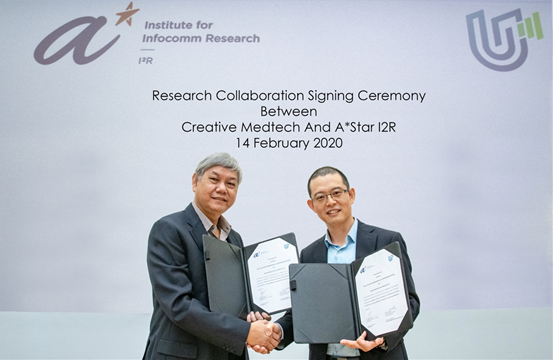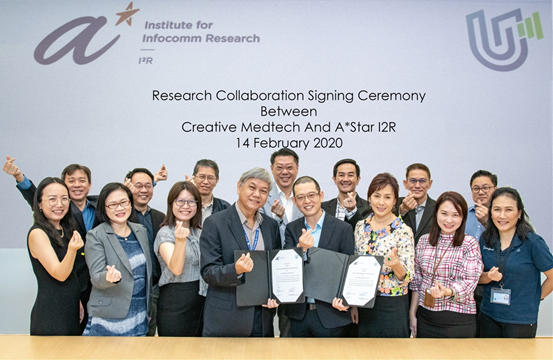Innovation Medical and the Institute of Information and Communication under the Singapore Agency for Science, Technology and Research have cooperated on the ultrasound-guided surgical navigation system
2020-02-28CREATIVE MEDTECH - Committed to the R&D and application of intelligent medical platforms and surgical robots. The company is collaborating on this research with the Institute of Information and Communications Research (hereinafter referred to as I2R) under the Agency for Science, Technology and Research (A*STAR) of Singapore. In this collaborative research with I2R, we can combine I2R's advantages in image processing with our innovation and medical capabilities and advantages in ultrasound and robotics to provide a solution to achieve three goals.
• Higher accuracy, less operation time, zero radiation.
• Ensure precise, repeatable routines for professional operators of all levels.
• Promote confidence and reliability in the use of robotic platforms for percutaneous aspiration instead of manual aspiration.
Ultrasound-guided surgical navigation system project introduction:
Percutaneous peritoneal interventional therapy is widely used in medical diagnosis and treatment, such as biopsy, nephrolithectomy, and tumor ablation. One common application is nephrolithectomy, a surgical procedure in which kidney stones are removed through a small incision through the skin. This invasive procedure can have complications because a long needle is inserted into the body without a direct view. Complications of this procedure include bleeding, damage to the organ or surrounding organs (colon, lung), incomplete treatment (stone removal or ablation of the lesion), infection, and sepsis. Clinicians and patients encounter the same issues during biopsies and hepatic tumor resections.
Kidney stones are very common all over the world. According to the National Kidney Foundation, the prevalence of kidney stones in the United States has risen from 3.8 percent in the late 1970s to 8.8 percent in the late 2000s, with the rise seen in both men and women as well as whites and blacks occur. The lifetime risk of developing kidney stones was 19 percent for men and 9 percent for women. The average treatment cost was $11,730, and the average operation time was more than 2 hours. (National Kidney Foundation; Journal of Endoscopic Urology. 2019/2016)
Nephrolithectomy has a steep learning curve, requiring more than 60 stages of steps to progress to an advanced level. One of the challenges is the establishment of a percutaneous nephrocentesis channel. According to a survey, only 11% of practicing urologists in the United States can routinely and accurately locate the biopsy channel [1]. The success rate of stone removal from single to multiple kidney stones is 73.4% to 92.8% [2].
Ultrasound and fluoroscopy are two commonly used methods of navigation. But most still use fluoroscopy during surgery [2]. Ultrasound systems are still suboptimal, with only 4% of cases using ultrasound guidance.
The goal of this project is to develop a CT\ultrasound fusion system to improve the safety and accuracy of ultrasound-guided biopsy needle insertion.
l The advantages of such a system would be easier and more precise piercing while reducing
• Surgical error rate
• Operation time
• Estimated blood loss
• Infection rate
l refer to
[1] VG Bird et al, "A practice model for the management of large kidney stones", Journal of Endourology, 17 August 2003 (6), 355-363
[2] J Tan et al., "Renal access through lower calices for stone removal after percutaneous nephrolithotomy is associated with higher risk of severe bleeding", Arch Med Sci, April 25, 2015, 11(2), 340-345
Appendix: 1. On February 14, 2020, Dr. GAO XIAOBIN (right), the CEO of Chuangke Medical, signed the signing ceremony with the Singapore Research Institute (left)

Appendix: 2. A group photo of both parties
